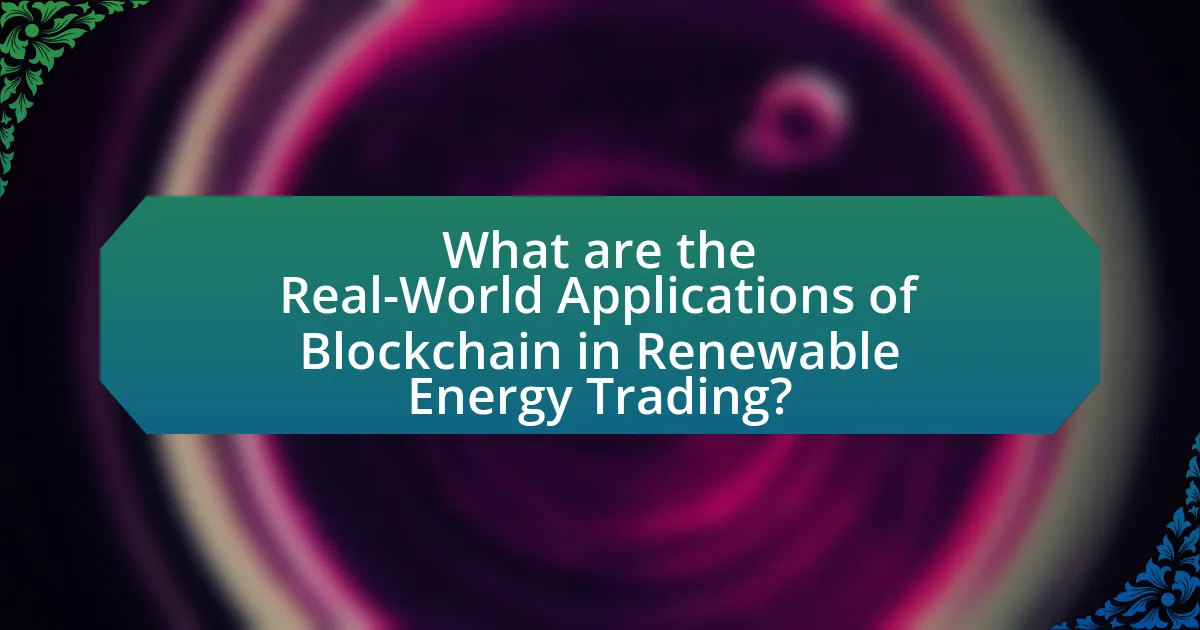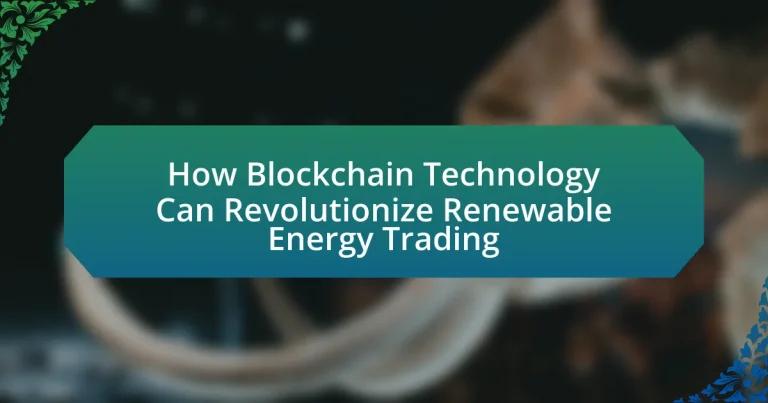Blockchain technology is a decentralized digital ledger that has the potential to transform renewable energy trading by enabling peer-to-peer transactions, enhancing transparency, and reducing costs. This article explores how blockchain functions in energy trading, highlighting key components such as decentralization, smart contracts, and security. It addresses current challenges in renewable energy markets, the limitations of traditional trading systems, and the role of intermediaries. Additionally, the article examines real-world applications and successful case studies of blockchain in energy trading, regulatory considerations, and best practices for implementation, providing a comprehensive overview of how blockchain can revolutionize the renewable energy sector.

What is Blockchain Technology and How Can It Impact Renewable Energy Trading?
Blockchain technology is a decentralized digital ledger that records transactions across multiple computers, ensuring that the data cannot be altered retroactively without the consensus of the network. This technology can significantly impact renewable energy trading by enabling peer-to-peer energy transactions, enhancing transparency, and reducing transaction costs. For instance, blockchain allows individuals with solar panels to sell excess energy directly to neighbors without intermediaries, which can lead to more efficient energy distribution and lower prices. According to a report by the International Renewable Energy Agency (IRENA), blockchain can facilitate decentralized energy systems, potentially increasing the share of renewables in the energy mix and promoting energy independence.
How does blockchain technology function in the context of energy trading?
Blockchain technology functions in energy trading by enabling decentralized and transparent transactions between energy producers and consumers. This technology allows for the creation of a secure, immutable ledger that records all energy transactions, ensuring that data is accurate and tamper-proof. For instance, peer-to-peer energy trading platforms utilize blockchain to facilitate direct exchanges of energy between users, reducing reliance on traditional intermediaries like utility companies. According to a report by the International Renewable Energy Agency (IRENA), blockchain can enhance the efficiency of energy trading by lowering transaction costs and increasing market access for renewable energy sources.
What are the key components of blockchain technology relevant to energy trading?
The key components of blockchain technology relevant to energy trading include decentralization, smart contracts, transparency, and security. Decentralization allows for peer-to-peer transactions without intermediaries, enabling direct energy trading between producers and consumers. Smart contracts automate and enforce agreements, ensuring that transactions are executed when predefined conditions are met, which enhances efficiency and reduces costs. Transparency is achieved through a shared ledger that records all transactions, allowing participants to verify and audit trades in real-time, thereby building trust among users. Lastly, security is provided through cryptographic techniques that protect transaction data from tampering and fraud, ensuring the integrity of the trading process. These components collectively facilitate a more efficient, reliable, and transparent energy trading ecosystem.
How does decentralization in blockchain enhance energy trading?
Decentralization in blockchain enhances energy trading by enabling peer-to-peer transactions without intermediaries, which reduces costs and increases efficiency. This structure allows energy producers and consumers to interact directly, facilitating real-time trading and improving market access. For instance, platforms like Power Ledger utilize blockchain to allow users to buy and sell excess renewable energy directly, leading to lower transaction fees and faster settlement times. Additionally, decentralization fosters transparency and security, as all transactions are recorded on an immutable ledger, reducing the risk of fraud and enhancing trust among participants.
What are the current challenges in renewable energy trading?
Current challenges in renewable energy trading include market volatility, regulatory uncertainty, and integration of decentralized energy sources. Market volatility arises from fluctuating energy prices and demand, which can hinder stable trading conditions. Regulatory uncertainty complicates compliance and can vary significantly across regions, affecting investment and operational decisions. Additionally, the integration of decentralized energy sources, such as solar and wind, presents logistical challenges in balancing supply and demand, as these sources are often intermittent. These factors collectively impede the efficiency and growth of renewable energy trading markets.
How do traditional trading systems limit renewable energy adoption?
Traditional trading systems limit renewable energy adoption by creating barriers such as high transaction costs, lack of transparency, and inefficiencies in energy distribution. These systems often rely on centralized models that hinder the integration of decentralized renewable energy sources, making it difficult for small producers to participate in the market. For instance, traditional energy markets typically impose significant fees for trading and require complex regulatory compliance, which can deter new entrants. Additionally, the opacity of these systems can lead to mistrust among stakeholders, further slowing the transition to renewable energy. According to a report by the International Renewable Energy Agency, these limitations can result in a slower adoption rate of renewable technologies, ultimately impacting global sustainability goals.
What role do intermediaries play in current energy trading models?
Intermediaries in current energy trading models facilitate transactions between energy producers and consumers, ensuring liquidity and market efficiency. They provide essential services such as risk management, price discovery, and regulatory compliance, which help stabilize the market. For instance, intermediaries often aggregate energy from multiple sources, allowing smaller producers to access larger markets, thus enhancing competition and driving down prices. Additionally, they play a crucial role in managing the complexities of energy contracts and ensuring that transactions adhere to legal and regulatory standards, which is vital for maintaining market integrity.

How Can Blockchain Revolutionize Renewable Energy Trading?
Blockchain can revolutionize renewable energy trading by enabling decentralized, transparent, and secure transactions between energy producers and consumers. This technology allows for peer-to-peer energy trading, where individuals can buy and sell excess energy directly without intermediaries, reducing costs and increasing efficiency. For instance, a study by the International Renewable Energy Agency (IRENA) highlights that blockchain can facilitate real-time energy trading, enhancing grid stability and promoting the integration of renewable sources. Additionally, blockchain’s immutable ledger ensures that all transactions are recorded transparently, fostering trust among participants and encouraging more investments in renewable energy projects.
What advantages does blockchain offer for renewable energy trading?
Blockchain offers several advantages for renewable energy trading, including enhanced transparency, increased efficiency, and improved security. The decentralized nature of blockchain allows for real-time tracking of energy transactions, ensuring that all parties have access to the same information, which reduces disputes and builds trust among participants. Additionally, smart contracts automate the trading process, minimizing the need for intermediaries and thereby lowering transaction costs. According to a report by the International Renewable Energy Agency (IRENA), blockchain can facilitate peer-to-peer energy trading, enabling consumers to buy and sell energy directly, which can lead to more competitive pricing and increased adoption of renewable energy sources.
How does transparency in blockchain improve trust among stakeholders?
Transparency in blockchain enhances trust among stakeholders by providing an immutable and publicly accessible record of transactions. This visibility allows all parties involved to verify and audit transactions independently, reducing the potential for fraud and manipulation. For instance, in renewable energy trading, stakeholders can track the origin and flow of energy credits, ensuring that claims about energy production and consumption are accurate. Research by the International Renewable Energy Agency (IRENA) highlights that transparency in energy transactions can lead to increased participation and investment, as stakeholders feel more secure in the integrity of the system.
What efficiencies can blockchain introduce to the trading process?
Blockchain can introduce significant efficiencies to the trading process by enhancing transparency, reducing transaction costs, and streamlining settlement times. The decentralized nature of blockchain allows for real-time tracking of transactions, which minimizes the need for intermediaries and reduces the risk of fraud. For instance, a study by the International Renewable Energy Agency (IRENA) highlights that blockchain can lower transaction costs by up to 30% in energy trading by automating processes and eliminating redundancies. Additionally, blockchain enables near-instantaneous settlement of trades, which can reduce the typical settlement period from days to minutes, thereby increasing liquidity in the market.
How can smart contracts facilitate renewable energy transactions?
Smart contracts can facilitate renewable energy transactions by automating and securing the process of buying and selling energy without intermediaries. These self-executing contracts, built on blockchain technology, ensure that transactions are transparent, tamper-proof, and executed only when predefined conditions are met, such as the delivery of energy or payment confirmation. For instance, a study by the International Renewable Energy Agency (IRENA) highlights that smart contracts can streamline peer-to-peer energy trading, allowing consumers to directly trade excess energy generated from solar panels with their neighbors, thus enhancing market efficiency and reducing costs.
What are smart contracts and how do they work in energy trading?
Smart contracts are self-executing contracts with the terms of the agreement directly written into code, operating on blockchain technology. In energy trading, smart contracts automate transactions between energy producers and consumers, ensuring that energy is bought and sold based on predefined conditions without the need for intermediaries. For instance, if a solar energy producer generates excess energy, a smart contract can automatically facilitate the sale of that energy to a consumer when specific criteria, such as price or availability, are met. This process enhances efficiency, reduces transaction costs, and increases transparency in energy markets, as all transactions are recorded on an immutable ledger.
How do smart contracts reduce transaction costs and time?
Smart contracts reduce transaction costs and time by automating and streamlining processes without the need for intermediaries. This automation minimizes the need for manual oversight, which traditionally incurs fees and delays. For instance, in renewable energy trading, smart contracts can execute transactions instantly when predefined conditions are met, eliminating the delays associated with traditional contract execution. According to a study by the International Renewable Energy Agency, the use of blockchain and smart contracts can reduce transaction costs by up to 30% in energy trading, demonstrating their efficiency and cost-effectiveness.

What are the Real-World Applications of Blockchain in Renewable Energy Trading?
Blockchain technology is applied in renewable energy trading primarily through decentralized energy marketplaces, peer-to-peer energy trading, and transparent tracking of renewable energy certificates. Decentralized energy marketplaces enable consumers and producers to trade energy directly, reducing reliance on traditional utilities and enhancing market efficiency. Peer-to-peer trading allows individuals to buy and sell excess energy generated from renewable sources, such as solar panels, directly to one another, fostering community engagement and optimizing energy distribution. Additionally, blockchain facilitates the transparent tracking of renewable energy certificates, ensuring authenticity and preventing fraud, which is crucial for regulatory compliance and consumer trust. These applications demonstrate how blockchain can enhance efficiency, transparency, and accessibility in renewable energy trading.
Which companies are currently utilizing blockchain for energy trading?
Companies currently utilizing blockchain for energy trading include Power Ledger, LO3 Energy, and WePower. Power Ledger enables peer-to-peer energy trading through its blockchain platform, allowing consumers to buy and sell renewable energy directly. LO3 Energy has developed a platform called Exergy that facilitates local energy trading among consumers and producers. WePower uses blockchain to create a marketplace for renewable energy, allowing producers to sell energy directly to consumers while ensuring transparency and efficiency in transactions. These companies exemplify the integration of blockchain technology in the energy sector, enhancing trading processes and promoting renewable energy usage.
What successful case studies demonstrate blockchain’s impact on energy trading?
Successful case studies demonstrating blockchain’s impact on energy trading include the Power Ledger project in Australia and the Brooklyn Microgrid initiative in the United States. Power Ledger utilizes blockchain technology to enable peer-to-peer energy trading, allowing consumers to buy and sell excess solar energy directly, which has resulted in increased energy efficiency and reduced costs for participants. The Brooklyn Microgrid employs a similar model, enabling local residents to trade renewable energy among themselves, fostering community engagement and promoting the use of clean energy sources. Both projects illustrate how blockchain can enhance transparency, reduce transaction costs, and facilitate decentralized energy markets, thereby revolutionizing renewable energy trading.
How are pilot projects shaping the future of blockchain in energy trading?
Pilot projects are significantly shaping the future of blockchain in energy trading by demonstrating practical applications and scalability of decentralized systems. These initiatives, such as the Power Ledger project in Australia and the LO3 Energy project in New York, have successfully facilitated peer-to-peer energy trading, allowing consumers to buy and sell excess renewable energy directly. The results from these pilot projects indicate increased efficiency, reduced transaction costs, and enhanced transparency in energy markets. For instance, Power Ledger reported a 50% reduction in energy trading costs compared to traditional methods, showcasing the potential for blockchain to transform energy trading dynamics.
What regulatory considerations exist for blockchain in renewable energy trading?
Regulatory considerations for blockchain in renewable energy trading include compliance with energy market regulations, data privacy laws, and anti-money laundering (AML) requirements. Energy regulators, such as the Federal Energy Regulatory Commission (FERC) in the United States, require that blockchain solutions adhere to existing market rules to ensure fair competition and consumer protection. Additionally, the General Data Protection Regulation (GDPR) in Europe mandates that personal data handled by blockchain systems must be protected, impacting how transactions are recorded and managed. Furthermore, blockchain platforms must implement AML measures to prevent illicit activities, which can complicate the decentralized nature of blockchain technology. These regulatory frameworks are essential for fostering trust and ensuring the legitimacy of blockchain applications in renewable energy trading.
How do regulations affect the implementation of blockchain technology?
Regulations significantly influence the implementation of blockchain technology by establishing legal frameworks that dictate how blockchain can be used in various sectors, including renewable energy trading. For instance, regulations can determine the compliance requirements for data privacy, security, and transaction transparency, which are critical for blockchain applications. In the renewable energy sector, specific regulations may mandate the use of blockchain for tracking energy credits or ensuring the authenticity of renewable energy certificates, thereby facilitating trust among stakeholders. Furthermore, regulatory clarity can encourage investment in blockchain solutions, as companies are more likely to adopt technology that aligns with established legal standards. For example, the European Union’s General Data Protection Regulation (GDPR) has implications for how blockchain handles personal data, influencing its design and operational protocols.
What are the potential legal challenges facing blockchain energy trading?
Potential legal challenges facing blockchain energy trading include regulatory compliance, data privacy issues, and contract enforceability. Regulatory compliance is critical as energy markets are heavily regulated, and blockchain solutions must align with existing laws governing energy trading, which can vary significantly by jurisdiction. Data privacy issues arise from the use of distributed ledger technology, which may conflict with regulations like the General Data Protection Regulation (GDPR) that protect personal data. Additionally, the enforceability of smart contracts, which automate transactions on blockchain, can be questioned in legal contexts, particularly regarding their interpretation and the jurisdiction governing them. These challenges necessitate careful navigation to ensure that blockchain energy trading can operate within the legal frameworks established for traditional energy markets.
What are the best practices for implementing blockchain in renewable energy trading?
The best practices for implementing blockchain in renewable energy trading include ensuring interoperability, establishing clear regulatory frameworks, and prioritizing data security. Interoperability allows different blockchain systems to communicate, facilitating seamless transactions across various platforms. Clear regulatory frameworks are essential to provide guidelines for compliance and to foster trust among participants in the trading ecosystem. Prioritizing data security protects sensitive information and builds confidence in the technology. These practices are supported by case studies, such as the Energy Web Foundation’s initiatives, which demonstrate successful blockchain applications in energy trading, highlighting the importance of these best practices in real-world scenarios.
How can stakeholders prepare for the transition to blockchain-based trading?
Stakeholders can prepare for the transition to blockchain-based trading by investing in education and training on blockchain technology, assessing their current trading processes for compatibility, and collaborating with technology providers to develop tailored solutions. Education and training will equip stakeholders with the necessary knowledge to understand blockchain’s functionalities and benefits, which is crucial given that a 2021 Deloitte survey indicated that 40% of executives believe blockchain will disrupt their industry. Assessing current processes ensures that stakeholders can identify areas for improvement and integration with blockchain systems. Collaboration with technology providers facilitates the development of customized blockchain solutions that meet specific trading needs, enhancing efficiency and transparency in renewable energy trading.
What common pitfalls should be avoided when adopting blockchain technology?
Common pitfalls to avoid when adopting blockchain technology include inadequate understanding of the technology, lack of clear use cases, and insufficient regulatory compliance. Organizations often underestimate the complexity of blockchain, leading to poorly designed implementations that fail to meet business needs. For instance, a study by Deloitte highlights that 74% of executives believe that a lack of understanding is a significant barrier to blockchain adoption. Additionally, failing to identify specific use cases can result in wasted resources and missed opportunities, as seen in various pilot projects that did not align with strategic goals. Lastly, neglecting regulatory frameworks can expose organizations to legal risks, as blockchain operates in a rapidly evolving regulatory landscape.




